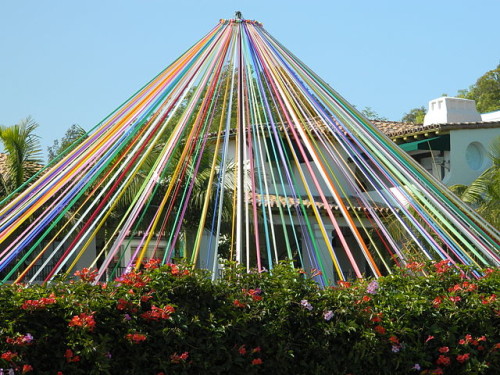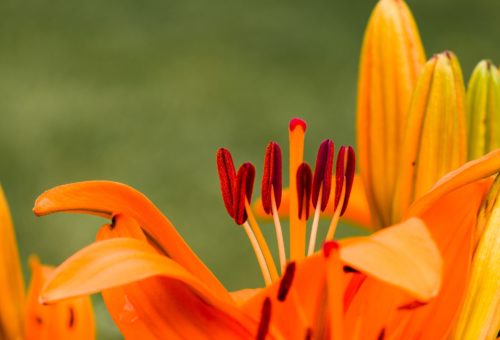For many Pagans, Heathens, and polytheists, it is once a time of celebration. The days surrounding the first of May mark many traditional spring festivals and religious holidays recognized around the world. Of these, the most well known is Beltane or Bealtaine, which, in some traditions, honors the union of goddess and god, or marks the beginning of a Celtic summer. It is also considered the high point of Spring on some Wiccan calendars.
In many secular and non-Pagan religious communities, the day is celebrated as May Day, complete with the iconic Maypole, music, and dancing.

[Photo Credit: Jengod via Wikimedia]
In ancient Greece, the holiday of Anthesteria was celebrated. Today it is more commonly called Protomagia. It is a day that recognizes the rebirth of nature and is associated with the well-known story of Persephone’s ascent from the Underworld. While some modern Hellenic polytheists celebrate this day in February, many celebrate it on the first of May. And, not long after, as spring continues its dance, some modern Pagans celebrate Thargelia, which is a birthday celebration for Apollon and Artemis.
These festivals and others herald the coming of summer or the apex of spring – a time of merriment, awakening and bounty; a liminal time when the barriers between our world and the other world are thinned. In many traditions and cultures, it is also a time of divine union and fertility.
But that does not apply to Pagans everywhere. Our friends in the Southern Hemisphere are readying for winter. The first of May marks the height of autumn and the end of the harvest season. The celebration of Samhain and other similar holidays that honor the dead or the Ancestors are now upon them.
Love, whose month is ever May,
Spied a blossom passing fair
Playing in the wanton air.
– William Shakespeare, from Love’s Labour’s Lost,
Act IV, Scene III
Here are some quotes for this season:
Twenty years ago on a Beltane Eve, I did my first ritual after moving to a rural home. In a secluded spot, surrounded by seven acres of undomesticated forest with only the stars and a single candle for illumination, I cast a circle and then called to the Green Man to come be with me in my Beltane magic. There was just me and my overpowering yearning to connect with the wild God energy of Nature. Sitting cross-legged with the moss-covered earth beneath me, I rocked back and forth, putting every ounce of my longings and love into my prayer and invocation, speaking out loud to the listening wilderness. – Karen Clark, from “An Encounter with the Green Man: Three Lessons to Inspire Your Beltane Magic”
“In ancient times Beltane was the beginning of summer, the year being divided into two seasons. That makes it a good time to celebrate beginnings of all sorts. […] This is the coming of the Tuatha De Danann to Ireland. How – or if – They left Ireland is a matter of speculation. Some say They went into the Otherworld, some say They went underhill and became the Fae, and some say They never left – people just stopped seeing Them. I think the answer varies from deity to deity. What’s most relevant to contemporary polytheists is that They are once again active in our world.” – John Beckett, from “Beltane – The Coming of the Gods”
“One challenge I have accepted for the upcoming season of Beltane is to think about three things that went well over the course of my day each evening just before I go to sleep. This is a small seed I can plant in my life, and I have been assured that the activity will become addictive. Research has shown that doing this simple act for six months causes people to have more life satisfaction and markedly less depression and anxiety.” – Allison Ehrman, from “The Well-being of Gardening”

[Pixabay]
“A bottle of Grouse was cracked open and poems were read aloud, voices raised against the wind. Under thick dark skies they drummed and danced through to a watery dawn, hurling themselves through the Beltane Fire. The season was changing and they intended to mark it, with an ancient Iron Age Celtic ritual of renewal, celebrating the end of darkness and the hope of summer to come.” – Laura Piper, from the BBC’s “Burning bright: Beltane festival celebrates 30 years of fire” (including photo gallery from the Edinburgh festival)
It was a lover and his lass,
With a hey, and a ho, and a hey nonino,
That o’er the green corn-field did pass,
In the spring time, the only pretty ring time,
When birds do sing, hey ding a ding, ding;
Sweet lovers love the spring.
– William Shakespeare, from As You Like It,
Act V, Scene III
A Very Merry May from The Wild Hunt!
The Wild Hunt is not responsible for links to external content.
To join a conversation on this post:
Visit our The Wild Hunt subreddit! Point your favorite browser to https://www.reddit.com/r/The_Wild_Hunt_News/, then click “JOIN”. Make sure to click the bell, too, to be notified of new articles posted to our subreddit.